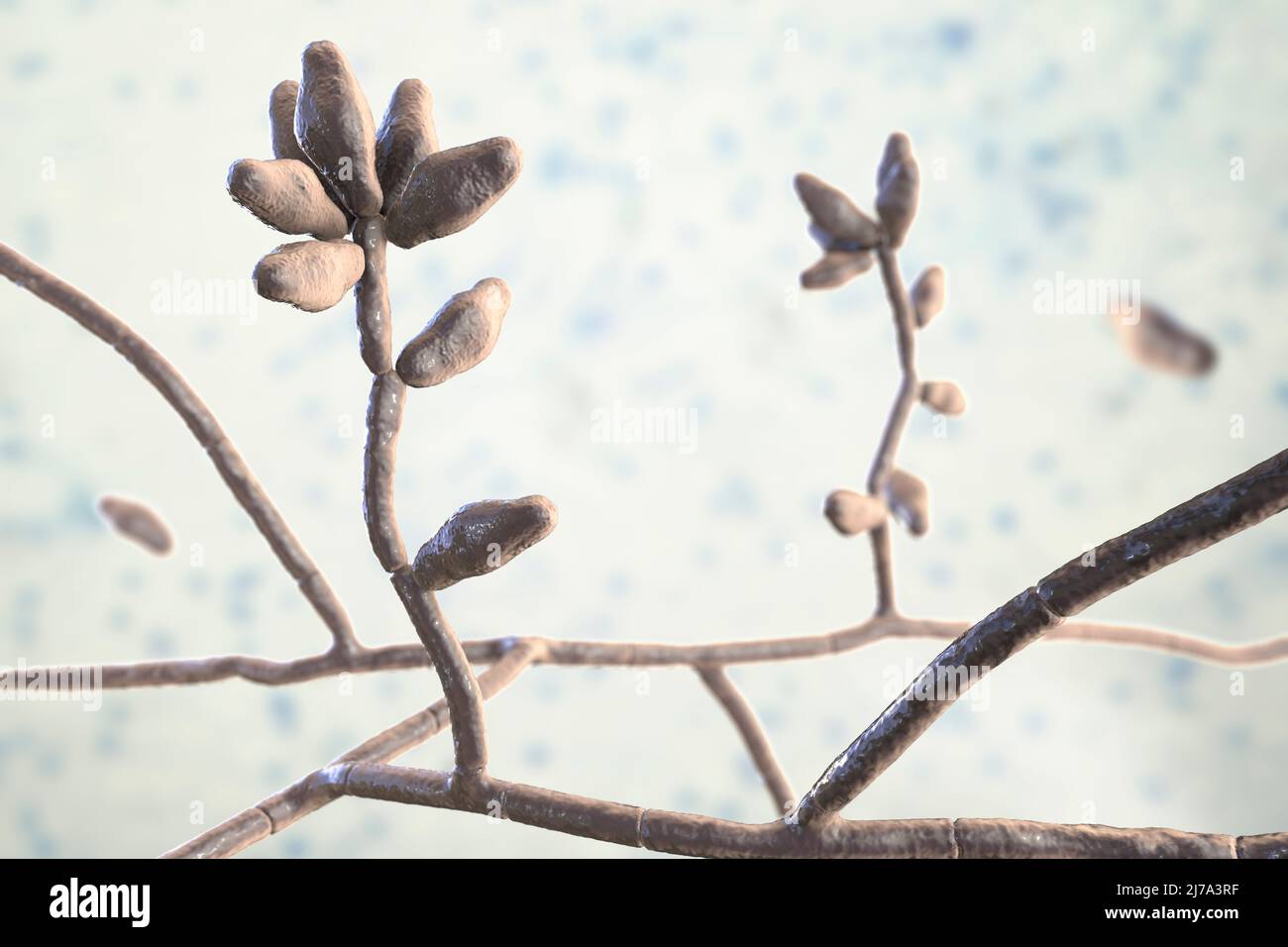Quick filters:
Curvularia geniculata Stock Photos and Images
 CURVULARIA GENICULATA Stock Photohttps://www.alamy.com/image-license-details/?v=1https://www.alamy.com/stock-photo-curvularia-geniculata-53859219.html
CURVULARIA GENICULATA Stock Photohttps://www.alamy.com/image-license-details/?v=1https://www.alamy.com/stock-photo-curvularia-geniculata-53859219.htmlRMD3HDYF–CURVULARIA GENICULATA
 Curvularia mould fungus, illustration Stock Photohttps://www.alamy.com/image-license-details/?v=1https://www.alamy.com/curvularia-mould-fungus-illustration-image469205059.html
Curvularia mould fungus, illustration Stock Photohttps://www.alamy.com/image-license-details/?v=1https://www.alamy.com/curvularia-mould-fungus-illustration-image469205059.htmlRF2J7A3RF–Curvularia mould fungus, illustration
 Curvularia geniculata Stock Photohttps://www.alamy.com/image-license-details/?v=1https://www.alamy.com/stock-photo-curvularia-geniculata-134986785.html
Curvularia geniculata Stock Photohttps://www.alamy.com/image-license-details/?v=1https://www.alamy.com/stock-photo-curvularia-geniculata-134986785.htmlRMHRH50H–Curvularia geniculata
 Scanning Electron Micrograph of Curvularia geniculata. Image courtesy CDC/Robert Simmons, Janice Haney Carr. 1984. Stock Photohttps://www.alamy.com/image-license-details/?v=1https://www.alamy.com/scanning-electron-micrograph-of-curvularia-geniculata-image-courtesy-image155848581.html
Scanning Electron Micrograph of Curvularia geniculata. Image courtesy CDC/Robert Simmons, Janice Haney Carr. 1984. Stock Photohttps://www.alamy.com/image-license-details/?v=1https://www.alamy.com/scanning-electron-micrograph-of-curvularia-geniculata-image-courtesy-image155848581.htmlRMK1FECN–Scanning Electron Micrograph of Curvularia geniculata. Image courtesy CDC/Robert Simmons, Janice Haney Carr. 1984.
 CURVULARIA GENICULATA Stock Photohttps://www.alamy.com/image-license-details/?v=1https://www.alamy.com/stock-photo-curvularia-geniculata-53859220.html
CURVULARIA GENICULATA Stock Photohttps://www.alamy.com/image-license-details/?v=1https://www.alamy.com/stock-photo-curvularia-geniculata-53859220.htmlRMD3HDYG–CURVULARIA GENICULATA
 Curvularia mould fungus, illustration Stock Photohttps://www.alamy.com/image-license-details/?v=1https://www.alamy.com/curvularia-mould-fungus-illustration-image469205063.html
Curvularia mould fungus, illustration Stock Photohttps://www.alamy.com/image-license-details/?v=1https://www.alamy.com/curvularia-mould-fungus-illustration-image469205063.htmlRF2J7A3RK–Curvularia mould fungus, illustration
 Curvularia geniculata Stock Photohttps://www.alamy.com/image-license-details/?v=1https://www.alamy.com/stock-photo-curvularia-geniculata-134986787.html
Curvularia geniculata Stock Photohttps://www.alamy.com/image-license-details/?v=1https://www.alamy.com/stock-photo-curvularia-geniculata-134986787.htmlRMHRH50K–Curvularia geniculata
 Scanning Electron Micrograph (SEM) of Curvularia geniculata, Scanning Electron Micrograph of Curvularia geniculata. Image courtesy CDC/Robert Simmons/Janice Haney Carr. 1984. Stock Photohttps://www.alamy.com/image-license-details/?v=1https://www.alamy.com/scanning-electron-micrograph-sem-of-curvularia-geniculata-scanning-image155848578.html
Scanning Electron Micrograph (SEM) of Curvularia geniculata, Scanning Electron Micrograph of Curvularia geniculata. Image courtesy CDC/Robert Simmons/Janice Haney Carr. 1984. Stock Photohttps://www.alamy.com/image-license-details/?v=1https://www.alamy.com/scanning-electron-micrograph-sem-of-curvularia-geniculata-scanning-image155848578.htmlRMK1FECJ–Scanning Electron Micrograph (SEM) of Curvularia geniculata, Scanning Electron Micrograph of Curvularia geniculata. Image courtesy CDC/Robert Simmons/Janice Haney Carr. 1984.
 Histopathologic changes found in black grain mycetoma in a dog due to Curvularia geniculata, revealed in the micrograph film, 1964. Image courtesy Centers for Disease Control (CDC) / Dr Lucille K Georg. Image courtesy CDC. () Stock Photohttps://www.alamy.com/image-license-details/?v=1https://www.alamy.com/histopathologic-changes-found-in-black-grain-mycetoma-in-a-dog-due-to-curvularia-geniculata-revealed-in-the-micrograph-film-1964-image-courtesy-centers-for-disease-control-cdc-dr-lucille-k-georg-image-courtesy-cdc-image178229508.html
Histopathologic changes found in black grain mycetoma in a dog due to Curvularia geniculata, revealed in the micrograph film, 1964. Image courtesy Centers for Disease Control (CDC) / Dr Lucille K Georg. Image courtesy CDC. () Stock Photohttps://www.alamy.com/image-license-details/?v=1https://www.alamy.com/histopathologic-changes-found-in-black-grain-mycetoma-in-a-dog-due-to-curvularia-geniculata-revealed-in-the-micrograph-film-1964-image-courtesy-centers-for-disease-control-cdc-dr-lucille-k-georg-image-courtesy-cdc-image178229508.htmlRMM9Y1FG–Histopathologic changes found in black grain mycetoma in a dog due to Curvularia geniculata, revealed in the micrograph film, 1964. Image courtesy Centers for Disease Control (CDC) / Dr Lucille K Georg. Image courtesy CDC. ()
 This photomicrograph shows a conidiophore of the fungus Curvularia geniculata, which can be dangerous, and is associated with various human infections such as onychomycosis, keratitis, sinusitis, mycetoma, pneumonia, endocarditis, cerebral abscess, and disseminated infection, 1963. Image courtesy CDC/Dr. Libero Ajello. Stock Photohttps://www.alamy.com/image-license-details/?v=1https://www.alamy.com/stock-photo-this-photomicrograph-shows-a-conidiophore-of-the-fungus-curvularia-170726555.html
This photomicrograph shows a conidiophore of the fungus Curvularia geniculata, which can be dangerous, and is associated with various human infections such as onychomycosis, keratitis, sinusitis, mycetoma, pneumonia, endocarditis, cerebral abscess, and disseminated infection, 1963. Image courtesy CDC/Dr. Libero Ajello. Stock Photohttps://www.alamy.com/image-license-details/?v=1https://www.alamy.com/stock-photo-this-photomicrograph-shows-a-conidiophore-of-the-fungus-curvularia-170726555.htmlRMKWN7CY–This photomicrograph shows a conidiophore of the fungus Curvularia geniculata, which can be dangerous, and is associated with various human infections such as onychomycosis, keratitis, sinusitis, mycetoma, pneumonia, endocarditis, cerebral abscess, and disseminated infection, 1963. Image courtesy CDC/Dr. Libero Ajello.
 This scanning electron micrograph (SEM) depicts a magnified view of a colony of the dematiaceous filamentous fungus Curvularia geniculata, revealing the morphologic details of the organism?s hyphae, and conidiophores topped with spore-containing conidia. Though normally found living in soil or decaying vegetation, Curvularia geniculata is pathogenic to humans, causing wound infections known as phaeohyphomycosis, which are fungal infections that can involve a number of bodily structures including the skin, respiratory tract, and brain, to name a few. Image courtesy CDC/Robert Simmons, Janice Ha Stock Photohttps://www.alamy.com/image-license-details/?v=1https://www.alamy.com/this-scanning-electron-micrograph-sem-depicts-a-magnified-view-of-image155848583.html
This scanning electron micrograph (SEM) depicts a magnified view of a colony of the dematiaceous filamentous fungus Curvularia geniculata, revealing the morphologic details of the organism?s hyphae, and conidiophores topped with spore-containing conidia. Though normally found living in soil or decaying vegetation, Curvularia geniculata is pathogenic to humans, causing wound infections known as phaeohyphomycosis, which are fungal infections that can involve a number of bodily structures including the skin, respiratory tract, and brain, to name a few. Image courtesy CDC/Robert Simmons, Janice Ha Stock Photohttps://www.alamy.com/image-license-details/?v=1https://www.alamy.com/this-scanning-electron-micrograph-sem-depicts-a-magnified-view-of-image155848583.htmlRMK1FECR–This scanning electron micrograph (SEM) depicts a magnified view of a colony of the dematiaceous filamentous fungus Curvularia geniculata, revealing the morphologic details of the organism?s hyphae, and conidiophores topped with spore-containing conidia. Though normally found living in soil or decaying vegetation, Curvularia geniculata is pathogenic to humans, causing wound infections known as phaeohyphomycosis, which are fungal infections that can involve a number of bodily structures including the skin, respiratory tract, and brain, to name a few. Image courtesy CDC/Robert Simmons, Janice Ha
 Black grain eumycotic mycetoma of subcutaneous tissue, caused by the fungus Curvularia geniculata, 1973. Image courtesy CDC/Dr. William Kaplan. Stock Photohttps://www.alamy.com/image-license-details/?v=1https://www.alamy.com/stock-photo-black-grain-eumycotic-mycetoma-of-subcutaneous-tissue-caused-by-the-135479032.html
Black grain eumycotic mycetoma of subcutaneous tissue, caused by the fungus Curvularia geniculata, 1973. Image courtesy CDC/Dr. William Kaplan. Stock Photohttps://www.alamy.com/image-license-details/?v=1https://www.alamy.com/stock-photo-black-grain-eumycotic-mycetoma-of-subcutaneous-tissue-caused-by-the-135479032.htmlRMHTBGTT–Black grain eumycotic mycetoma of subcutaneous tissue, caused by the fungus Curvularia geniculata, 1973. Image courtesy CDC/Dr. William Kaplan.
 Photomicrograph of the histopathologic changes found in black grain mycetoma in a dog, caused by Curvularia geniculata, 1964. Image courtesy Centers for Disease Control and Prevention (CDC) / Dr Lucille K. Georg. () Stock Photohttps://www.alamy.com/image-license-details/?v=1https://www.alamy.com/photomicrograph-of-the-histopathologic-changes-found-in-black-grain-mycetoma-in-a-dog-caused-by-curvularia-geniculata-1964-image-courtesy-centers-for-disease-control-and-prevention-cdc-dr-lucille-k-georg-image242390674.html
Photomicrograph of the histopathologic changes found in black grain mycetoma in a dog, caused by Curvularia geniculata, 1964. Image courtesy Centers for Disease Control and Prevention (CDC) / Dr Lucille K. Georg. () Stock Photohttps://www.alamy.com/image-license-details/?v=1https://www.alamy.com/photomicrograph-of-the-histopathologic-changes-found-in-black-grain-mycetoma-in-a-dog-caused-by-curvularia-geniculata-1964-image-courtesy-centers-for-disease-control-and-prevention-cdc-dr-lucille-k-georg-image242390674.htmlRMT29RNP–Photomicrograph of the histopathologic changes found in black grain mycetoma in a dog, caused by Curvularia geniculata, 1964. Image courtesy Centers for Disease Control and Prevention (CDC) / Dr Lucille K. Georg. ()
 CURVULARIA GENICULATA Stock Photohttps://www.alamy.com/image-license-details/?v=1https://www.alamy.com/stock-photo-curvularia-geniculata-53859222.html
CURVULARIA GENICULATA Stock Photohttps://www.alamy.com/image-license-details/?v=1https://www.alamy.com/stock-photo-curvularia-geniculata-53859222.htmlRMD3HDYJ–CURVULARIA GENICULATA
 Curvularia mould fungus, illustration Stock Photohttps://www.alamy.com/image-license-details/?v=1https://www.alamy.com/curvularia-mould-fungus-illustration-image469205056.html
Curvularia mould fungus, illustration Stock Photohttps://www.alamy.com/image-license-details/?v=1https://www.alamy.com/curvularia-mould-fungus-illustration-image469205056.htmlRF2J7A3RC–Curvularia mould fungus, illustration
 Curvularia geniculata Stock Photohttps://www.alamy.com/image-license-details/?v=1https://www.alamy.com/stock-photo-curvularia-geniculata-134986788.html
Curvularia geniculata Stock Photohttps://www.alamy.com/image-license-details/?v=1https://www.alamy.com/stock-photo-curvularia-geniculata-134986788.htmlRMHRH50M–Curvularia geniculata
 Curvularia mould fungus, illustration Stock Photohttps://www.alamy.com/image-license-details/?v=1https://www.alamy.com/curvularia-mould-fungus-illustration-image469205054.html
Curvularia mould fungus, illustration Stock Photohttps://www.alamy.com/image-license-details/?v=1https://www.alamy.com/curvularia-mould-fungus-illustration-image469205054.htmlRF2J7A3RA–Curvularia mould fungus, illustration
 Curvularia mould fungus, illustration Stock Photohttps://www.alamy.com/image-license-details/?v=1https://www.alamy.com/curvularia-mould-fungus-illustration-image469205062.html
Curvularia mould fungus, illustration Stock Photohttps://www.alamy.com/image-license-details/?v=1https://www.alamy.com/curvularia-mould-fungus-illustration-image469205062.htmlRF2J7A3RJ–Curvularia mould fungus, illustration
 Curvularia mould fungus, illustration Stock Photohttps://www.alamy.com/image-license-details/?v=1https://www.alamy.com/curvularia-mould-fungus-illustration-image469205066.html
Curvularia mould fungus, illustration Stock Photohttps://www.alamy.com/image-license-details/?v=1https://www.alamy.com/curvularia-mould-fungus-illustration-image469205066.htmlRF2J7A3RP–Curvularia mould fungus, illustration
 Curvularia mould fungus, illustration Stock Photohttps://www.alamy.com/image-license-details/?v=1https://www.alamy.com/curvularia-mould-fungus-illustration-image469205057.html
Curvularia mould fungus, illustration Stock Photohttps://www.alamy.com/image-license-details/?v=1https://www.alamy.com/curvularia-mould-fungus-illustration-image469205057.htmlRF2J7A3RD–Curvularia mould fungus, illustration
 Curvularia mould fungus, illustration Stock Photohttps://www.alamy.com/image-license-details/?v=1https://www.alamy.com/curvularia-mould-fungus-illustration-image469205053.html
Curvularia mould fungus, illustration Stock Photohttps://www.alamy.com/image-license-details/?v=1https://www.alamy.com/curvularia-mould-fungus-illustration-image469205053.htmlRF2J7A3R9–Curvularia mould fungus, illustration
 Curvularia mould fungus, illustration Stock Photohttps://www.alamy.com/image-license-details/?v=1https://www.alamy.com/curvularia-mould-fungus-illustration-image469205058.html
Curvularia mould fungus, illustration Stock Photohttps://www.alamy.com/image-license-details/?v=1https://www.alamy.com/curvularia-mould-fungus-illustration-image469205058.htmlRF2J7A3RE–Curvularia mould fungus, illustration
 Curvularia mould fungus, illustration Stock Photohttps://www.alamy.com/image-license-details/?v=1https://www.alamy.com/curvularia-mould-fungus-illustration-image469205052.html
Curvularia mould fungus, illustration Stock Photohttps://www.alamy.com/image-license-details/?v=1https://www.alamy.com/curvularia-mould-fungus-illustration-image469205052.htmlRF2J7A3R8–Curvularia mould fungus, illustration

